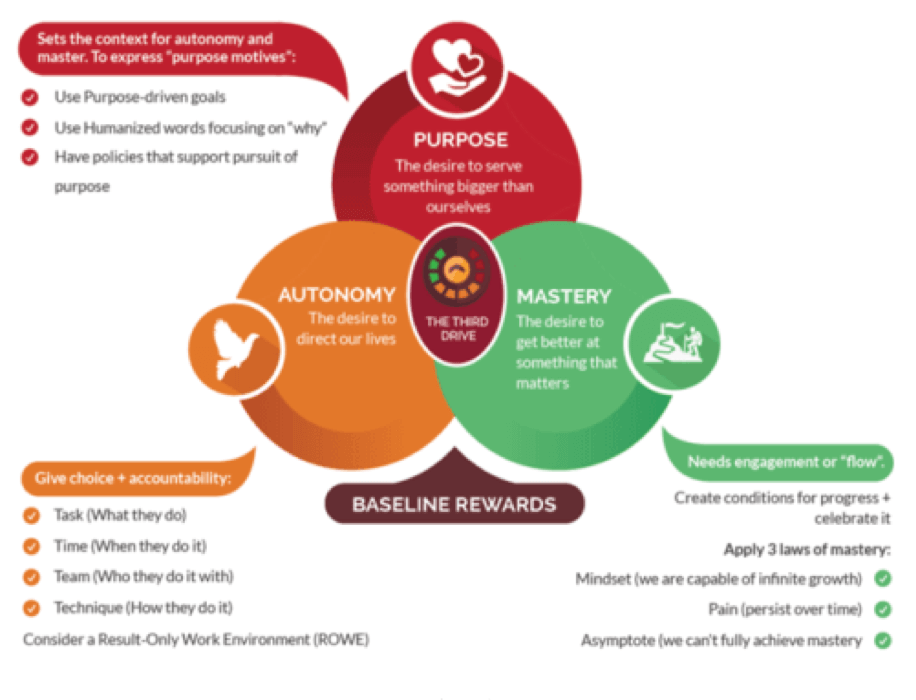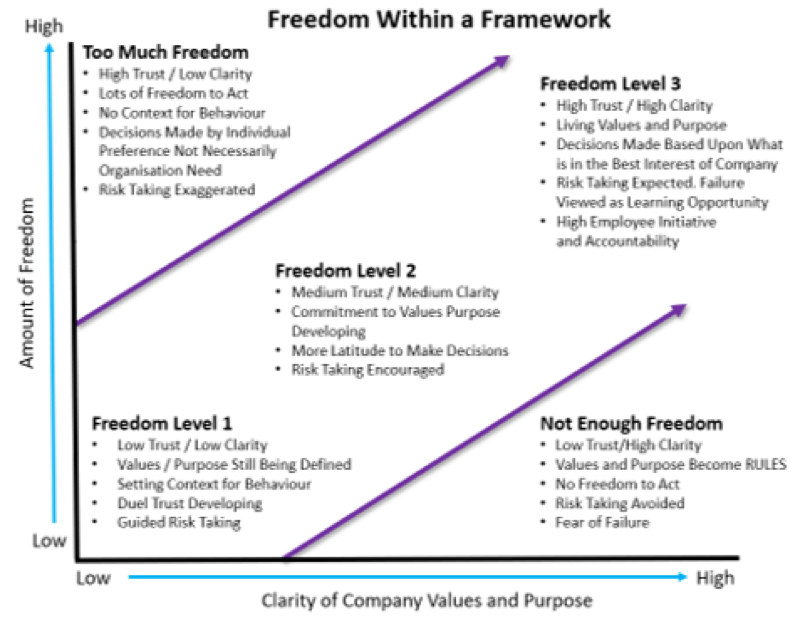Practical steps and tactics to set leaders and employees up for success
The concept of employee motivation is something that organizational development professionals have been thinking about and researching for decades. Where once money and other tangible rewards were considered to be the primary ways to motivate staff, there’s since been a move towards more intrinsic rewards, such as flexible working and professional development.
In 2010’s ‘Drive’, Dan Pink eloquently outlined three key factors that influence motivation:
Over the last few years, I’ve seen and experienced a tangible increase in the word ‘autonomy’ and other related terms and synonyms. It feels as though organizations have developed a renewed sense of duty to remind employees that they can and should be autonomous within their roles and it’s something I’d like to focus on in more detail within this post.
As with any movement or initiative, nothing is ever clear-cut. Whilst autonomy and accountable freedom sound like common sense and ‘win-win’, there is always another side to the story. One person’s idea of autonomy may be another person’s dereliction of duty or insubordination so it’s important that clear definitions are in place. It’s equally important to align any initiative with the organization's overall culture and appetite otherwise inevitable tensions will result.
Download our Free Resource – Marketing careers and skills development workbook
Our guide shows you how to map out your personal short-term and long-term goals, become more productive in your day-to-day work, identify your key motivators, analyze your digital marketing skills, how to leverage your strengths, and understand the different paths you can take to reach your goals.
Access the Marketing careers and skills development workbook template
Key benefits of promoting accountable freedom
Giving people autonomy and freedom in the way they work can increase both motivation and morale within the organization. The four main areas to provide autonomy include:
- Task
- Time
- Technique
- Team
The goal is to give people a problem and allow them to find a solution for themselves. Although the end result may not be perfect, you will benefit in the long-term from improved motivation and creativity).
If you’re unsure how autonomous your team current is, encourage them to ask themselves the following questions related to the ‘four Ts’ above:
- How much autonomy do you have over your tasks at work – your main responsibilities and what you do on a given day?
- How much autonomy do you have over your time at work – for example, when you arrive, when you leave and how you allocate your hours?
- How much autonomy do you have over your team at work – that is, to what extent are you able to choose the people with whom you typically collaborate?
- How much autonomy do you have over your technique at work – how you actually perform the main responsibilities of your job?
The concept of accountable freedom is made up of two main elements:
- Accountability - giving people the opportunity to exercise personal choice and judgement around what they do and when they do it
- Freedom - the opportunity to make decisions within an agreed framework that works for both customers and colleagues
Accountable freedom is about creating a culture where people have the opportunity to make decisions in the interest of the customer without the need to seek permission and gain sign-off on every occasion. This type of cultural shift takes time to implement and will not suit every organization. However, giving employees the ability to make their own decisions will reduce bureaucracy whilst improving creativity and motivation.

Five ways to promote accountable freedom effectively in your organization
Although the idea of accountable freedom sounds good, putting this into practice is easier said than done. The cultural differences referenced above, as well as the lack of experience in making this happen, mean that business owners and managers looking to embrace accountable freedom will need to follow practical steps:
1. Give people permission
This first step might sound straightforward but it’s a big leap forward. Accountable freedom is about trusting our employees to do the right thing by enabling them to make smart decisions.
But it’s also making everyone aware that they should be accountable for the choices they make. This helps place an emphasis on the need to make sound decisions that are in the best interests of the company.
2. Create ‘freedom within a framework’
Many employees may not be used to the concept of accountable freedom. It’s therefore important to provide guidelines and set the boundaries within which they are free to take accountability for decisions.
One possible solution is to employ ‘freedom within a framework’. The iClif Leadership and Governance Centre defines this as:
“Providing employees with a context for behaviour and performance. It establishes adaptable parameters that give employees a sense of control and ownership because they know they are not locked into fixed rules”.
Establishing Freedom within a framework will be different for every company and is based upon two important and interdependent dimensions: freedom (trust) and values and purpose. The framework begins and ends with your organization’s values and purpose which set the context for priorities, actions, and decisions employees make. The figure below depicts how varying levels of leadership trust and clarity of values and purpose impacts an organization’s performance:
By giving people a clear sense of you company’s purpose, priorities and principles (i.e. a galvanizing framework), leaders can equip employees to make autonomous decisions that are in the company’s best interests
3. Share success stories
As you begin to introduce the concept and value of accountable freedom into the company, it’s important to keep the momentum going and encourage managers and employees to keep practicing. There will be moments along the way when things don’t go to plan.
For example, there may be a misinterpretation of when permission for a certain decision was required. The key is to learn from mistakes and promote the success stories to everyone else can learn from different examples.
4. Coach judgement
Good judgement involves considering the consequences of one's decisions, thinking before acting and having the right tools to make good decisions in a variety of situations. Jeff Bezos, Amazon’s founder and CEO claims that most decisions should probably be made with somewhere around 70% of the information you wish you had. However, good judgment and decision-making takes time and experience to perfect.
It’s therefore important for leaders to coach employees and what good judgement looks like, using their own experiences to bring this to life. Regular coaching will give the team more confidence to make their own decision without the fear of failure.
5. Continuous improvement
Creating accountable freedom will not happen overnight. Leaders must set the vision, guidelines and best practice and then listen to what is and isn’t working so that changes and adjustments can be made.
For example, there may be out of date rules or received wisdom preventing employees from taking accountability. By keeping an ear to the ground and checking in with staff, leaders can identify ways to continually improve ways of working throughout the company and put in place the right rules and policies to make this happen.
Conclusion
Encouraging accountability is a sound ambition and one that can increase efficiency, creativity and motivation across the workforce. Giving people the opportunity to make decisions without the constant need for approval is both liberating and rewarding.
However, there is always a catch. The businesses that make accountable freedom work are the ones with a clear set of values and established guidelines of what is/ isn’t acceptable. They are also businesses with good leaders throughout the organization or help and support employees, giving them the freedom to be accountable without the fear of failure.








